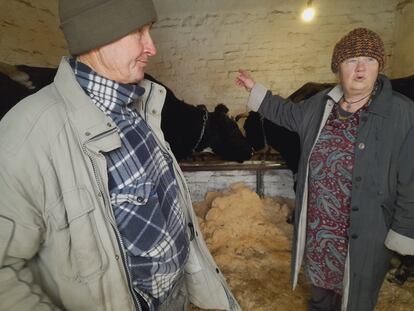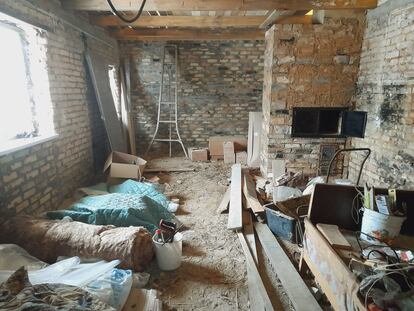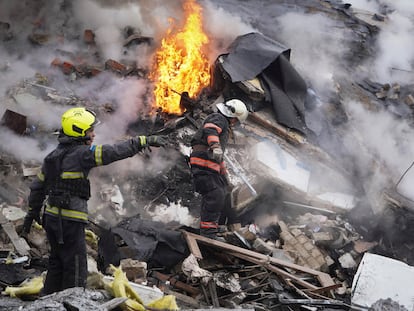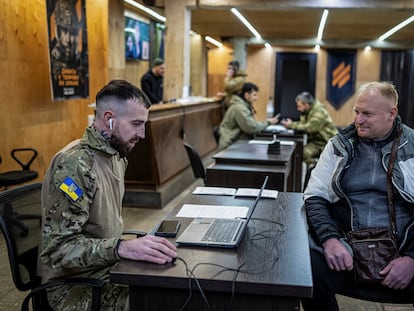Liudmila and Gregori’s war: Rebuilding a lifelong home at 70 years old in Ukraine
Kyiv starts issuing new housing certificates for those whose homes were destroyed by the Russian offensive. Many do not want to leave their land even though they have not had a decent roof over their heads for almost two years


A few phrases from Liudmila, 68, are enough to get a glimpse into her marriage to Gregori, 73. When asked about what she does for a living, she says that what she really does is give him a hard time. Gregori laughs behind her back, on the snow-covered way back from his small stable to the module where the couple now lives. Liudmila also mockingly says that the construction of their new house is going slowly; that she has ailments, arthritis, gets dizzy, but the worst part is that her father was better off at 80 years old than she will be. Gregori is resigned but still smiles. On March 29, 2022, a bomb — whether it was dropped by the enemy or friendly fire is unknown — blew up the Vovks’ home in the Ukrainian village of Zahaltsi, about 43.5 miles northwest of Kyiv. They had already fled. They had cows, ducks, chickens; crops of tomatoes, barley, oats, potatoes. The Russians razed and ate everything. Soon, it will be two years since that happened and Liudmila and Gregori will still not be sleeping in decent housing. Reconstruction in Ukraine is progressing for the thousands of people affected, but very slowly.
In many ways, this couple’s situation is a good example of how war can take someone who lives perfectly well with what they have and send them into the abyss. Zahaltsi is a small town a few miles from Borodyanka, one of the symbols of Russian barbarism. In this municipality, the air force fiercely unloaded, lifting the gable roofs of dozens of houses. Liudmila and Gregori had their farm and land on which they subsisted. They spent what little savings they had on a trip to Slovakia, where one of their four children lives. He gave them some money to return to Ukraine at the end of April of that year. The Russians were gone, but so were their animals. They found the severed head of a bull they had and pieces of meat stored in a refrigerator. “It really hurt when I saw it,” Liudmila recounts. “I was trying to go to the orchard without looking at how the house had been left.”
Reconstruction in Ukraine is not monolithic. A study by the Kyiv School of Economics puts the number of houses damaged since the beginning of the full-scale invasion at 167,200, at least. Small repairs were done as soon as the Russians fled; soon after, major damage was dealt with by volunteers, humanitarian agencies, local governments and the state. The difficult part was and is the third category, destroyed and uninhabitable houses. That is where the Vovk couple fits. There are cases in which destroyed houses were repaired from top to bottom, but that depends on the couple’s own resources or external help. In the latter case, private companies, for example, must comply with the protocols of the state or the U.N., which coordinate the work, in addition to finding someone to do the labor.

Yurii Glava, 47, from Novosilki, is an engineer who specializes in reconstruction. He worked for Miyamoto International on restoring the Zahaltsi kindergarten (about $29.8 million). They wanted to prove that it was possible to recover something destroyed without spending a lot of money in an adequate amount of time. “Rebuilding a school to meet government standards or U.N. protocols,” says Glava, “complicates the process, and subcontractors, the ones that have to do it, end up turning down these assignments.”
Restoration or a new house
The government is now working with the eVidnovlennya (eRecovery) program, a digital platform launched in May 2023 with which it is coordinating reconstruction work. According to data provided by the Ministry of Infrastructure, as of January 16, 35,100 requests for repairs have been addressed, at a total cost of €78 million ($84.6 million). Now comes the next phase, the certificate program: the owners of houses destroyed by the war can have access to new housing, after evaluation by the administration (always via internet). For example, the first case to be done was a woman from Hostomel, an area in the Kyiv region attacked by Russia, who was granted a house in Bucha. According to Infrastructure, there are already about 8,000 applications for certificates and 76 have been approved so far.
But that is not the case for Liudmila and Gregori, who, after almost half a century on that piece of land, do not plan to go anywhere. “Our dream,” he says, “is to rebuild the kitchen so we can live there.” The kitchen in many homes in rural Ukraine is located in a separate house, next to the main house, where the living room and bedrooms are located. Here, reconstruction began with demolition. Liudmila says that the first thing they did after returning was demolish what was left of her house down to the pillars. “I begged the neighbor to let me have the bulldozer,” she says as she cuts a piece of cake and pours tea, “and we pulled the house down.” They buried the bodies of the cows that had died, eaten by the dogs.
While their land was turned upside down, Liudmila and Gregori lived in their son’s house, which was still standing, if damaged. Volunteers and humanitarian organizations began bringing in food and supplies. A Polish religious organization provided them with a small module where they sleep next to a stove, while some donations allowed them to buy cows, a milking machine and other animals to recover their farm and start over again.
Help for paying the bills
The Vovks depend on the help of their son and volunteers to keep moving forward. “I want us to be done by summer,” says Liudmila, “and see if the war is over too.” The two of them do what they can while milking their two cattle a couple of times a day, tending to their brood of ducks, feeding the chickens so that they give them good eggs, and salvaging something from their two greenhouses in the sub-zero temperatures. The inside of their future home still displays bare beams and bricks. A handful of huge rolls of insulation awaits at the entrance. There are no windows, but the roof is in place. An American donor gave them $1,800, which covered the work. They also each receive about $54 a month from the state, which considers them internally displaced persons — there are 3.7 million in the whole country — even though the module is a stone’s throw away from their former home. “It gives us enough for the bills,” Gregori points out.

Zahaltsi Mayor Sergei Nedashkivski, 50, likes the government certificates idea. “I would accept it,” he says from his office. Asked why some reconstruction work is going so slowly, he gestures that they are doing what they can with what they have. “You have to understand,” Nedashkivski says, “that the state doesn’t have that much money or construction [supplies].” The cost of housing damage caused by the war alone is estimated at €51 billion ($55 billion). Others are filling in the gaps. In Zahaltsi, for example, almost two years after the Russian offensive, the school is still not operational. The Hungarian state is responsible for restoring it, and its reopening is planned for the next school year. The mayor also points to another small problem: elderly people like the Vovks have not yet been able to gather the property documents they need to access state programs.
There is no more than 20 inches between Liudmila’s and Gregori’s beds. At their feet they can fit a small table with a TV, a refrigerator, a kitchen cabinet, a closet with clothes and a stove. While she continues to bring out jars of cottage cheese, jams and pies, he comes and goes to see the cows and chickens.
— Liudmila, would you leave here to have a new house?
— We don’t want to go anywhere, have you seen the land we have here? Even though many of our neighbors have died, we still all know each other.
Sign up for our weekly newsletter to get more English-language news coverage from EL PAÍS USA Edition
Tu suscripción se está usando en otro dispositivo
¿Quieres añadir otro usuario a tu suscripción?
Si continúas leyendo en este dispositivo, no se podrá leer en el otro.
FlechaTu suscripción se está usando en otro dispositivo y solo puedes acceder a EL PAÍS desde un dispositivo a la vez.
Si quieres compartir tu cuenta, cambia tu suscripción a la modalidad Premium, así podrás añadir otro usuario. Cada uno accederá con su propia cuenta de email, lo que os permitirá personalizar vuestra experiencia en EL PAÍS.
¿Tienes una suscripción de empresa? Accede aquí para contratar más cuentas.
En el caso de no saber quién está usando tu cuenta, te recomendamos cambiar tu contraseña aquí.
Si decides continuar compartiendo tu cuenta, este mensaje se mostrará en tu dispositivo y en el de la otra persona que está usando tu cuenta de forma indefinida, afectando a tu experiencia de lectura. Puedes consultar aquí los términos y condiciones de la suscripción digital.
More information
Últimas noticias
Maduro pleads not guilty before the federal court in New York: ‘I am still the president of Venezuela’
A new test can detect Alzheimer’s from a finger prick
UN team enters Sudanese city of El Fasher after paramilitary massacre: ‘It’s like a ghost town’
A recipe for resistance: Indigenous peoples politicize their struggles from the kitchen
Most viewed
- Gilles Lipovetsky: ‘If you want to live better and fall in love, take Prozac, don’t look to philosophy’
- Alain Aspect, Nobel laureate in physics: ‘Einstein was so smart that he would have had to recognize quantum entanglement’
- Alvin Hellerstein, a 92-year-old judge appointed by Bill Clinton, to preside over Maduro’s trial in New York
- Why oil has been at the center of Venezuela-US conflicts for decades
- Maduro’s downfall puts China’s relationship with Venezuela to the test










































